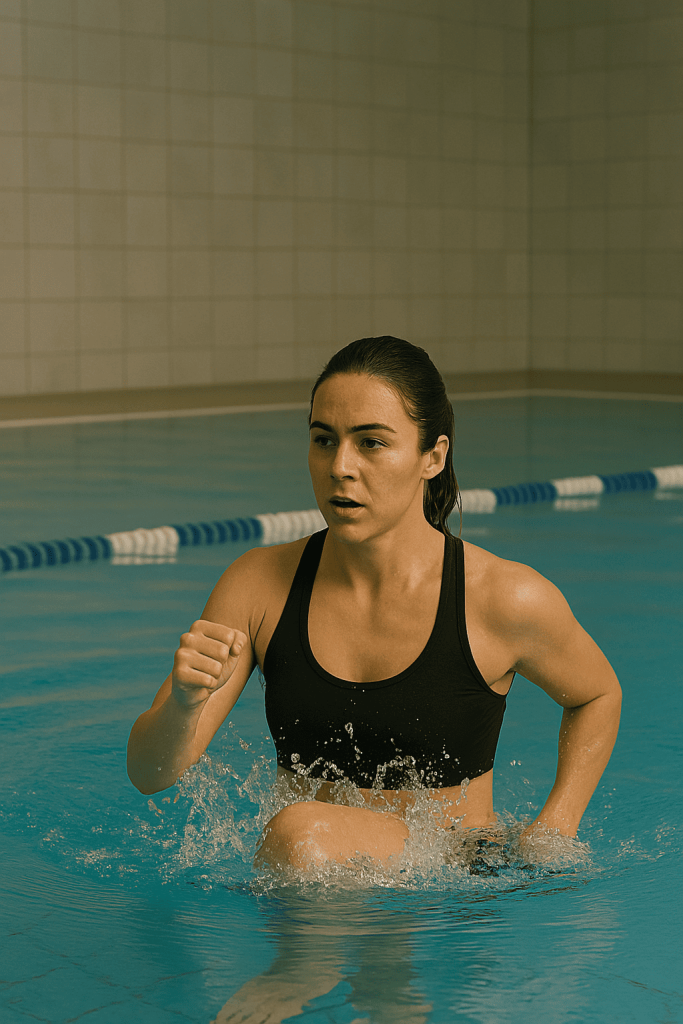21 de April de 2025
HIIT Pool Workout: Exercise Guide, Tips and Benefits
Incorporating High-Intensity Interval Training (HIIT) into the pool offers a unique, joint-friendly method for improving cardiovascular endurance, muscular strength, and overall athletic conditioning. Ideal for athletes in recovery, individuals managing joint pain, or anyone looking to diversify their training, HIIT pool workouts blend the metabolic demands of high-intensity circuits with the resistance and buoyancy of water. This guide will explore how to structure effective HIIT sessions in the pool, the science-backed benefits, and how it fits into a comprehensive Strength and Conditioning plan.

What Is a HIIT Pool Workout?
A HIIT pool workout involves short bursts of maximum-effort exercises performed in water, followed by brief periods of rest or active recovery. These workouts use the natural resistance of water to increase training intensity without adding joint stress. Movements like sprints, high-knee runs, tucks, jumps, and push-offs are performed with explosive effort, engaging both upper and lower body.
Compared to traditional HIIT, the aquatic environment reduces ground reaction force while increasing muscular demand due to constant drag. This makes pool-based HIIT ideal for improving power, speed, and aerobic capacity while minimizing fatigue and injury risk.
How to Structure a HIIT Pool Workout
A typical HIIT pool session includes:
- Warm-Up (5–10 minutes): Light swimming, arm circles, bodyweight squats in water.
- Main Set (20–25 minutes):
- 30 seconds of explosive work (e.g., water sprints)
- 15–30 seconds of rest or active movement (light kicking or water walking)
- Repeat for 8–12 rounds
- Cool-Down (5–10 minutes): Light swimming, stretching shoulders, hips, and calves.
Work-to-rest ratios can be adjusted depending on your conditioning level and the goals of your training block.
Example HIIT Pool Circuit
- Water Sprint (Shallow End to Deep) – 30s
- Tuck Jumps in Place – 30s
- High Knees Run – 30s
- Underwater Push-Offs – 30s
- Rest or Water Walking – 30s
Repeat for 4 rounds.

Muscles Worked During a HIIT Pool Workout
- Quadriceps and Hamstrings: Engaged during running, tucks, and jumping motions. These muscles drive lower body power and acceleration.
- Glutes: Activated through push-offs and water resistance exercises. Crucial for propulsion and explosive movement.
- Core Muscles: Stabilize the trunk during dynamic water movements. Help maintain alignment and prevent compensations.
- Shoulders and Arms: Used during underwater propulsion and recovery exercises. Support balance and drive in upper-body motions.
The water’s multidirectional resistance forces constant muscular engagement, making every movement a full-body challenge.
Benefits of HIIT Pool Training
- Low-Impact on Joints: Ideal for athletes with injuries or those in need of recovery.
- Full-Body Engagement: Resistance in all directions maximizes muscle activation.
- Improved Cardiovascular Fitness: Interval work elevates heart rate efficiently.
- Reduced Fatigue: The cooling effect of water helps regulate core temperature and prolong effort.
- Rehab-Friendly Conditioning: Great for offloading while still challenging energy systems.
When integrated into a structured Strength and Conditioning program, HIIT pool workouts can improve aerobic base, recovery efficiency, and resilience.
Common Mistakes to Avoid
- Skipping the Warm-Up: Transitioning into explosive work without preparation increases injury risk.
- Poor Technique: Sloppy movement reduces muscle recruitment and may cause discomfort even in water.
- Neglecting Rest Intervals: Recovery is key to maintaining performance across sets.
- Using Overly Shallow or Deep Water: Match water depth to exercise demands to ensure safety and effectiveness.
Variations of HIIT Pool Workouts
- Deep Water HIIT: Using a flotation belt to train without foot contact, increasing core and hip engagement.
- Resistance Tools: Add aqua dumbbells, resistance gloves, or drag socks to increase intensity.
- Sport-Specific HIIT: Mimic athletic movement patterns (e.g., lateral shuffles for tennis or underwater bounds for basketball).
How to Include HIIT Pool Workouts in Your S&C Routine
These sessions are best used during recovery days, aerobic base phases, or as part of a deload week. Coaches can implement HIIT pool work to enhance energy system development while limiting cumulative joint stress. For athletes undergoing rehab, it serves as a safe yet effective way to maintain conditioning.
While not typically measured by velocity based training devices, the principles of Velocity Based Training still apply. Explosive intent, fatigue monitoring, and movement quality are critical, especially in high-output bursts.
FAQs About HIIT Pool Workouts
Can you do a HIIT workout in the pool?
Yes, pool-based HIIT workouts involve alternating short bursts of intense effort (like water sprints or tucks) with brief recovery periods. These sessions can be highly effective for boosting cardio and muscular endurance while being easy on the joints.
Is swimming good for HIIT?
Absolutely. Swimming can be adapted into a HIIT format by incorporating intervals of sprinting and recovery. It’s a full-body, low-impact option that builds cardiovascular fitness and muscular endurance simultaneously.
What exercise burns the most belly fat in the pool?
High-intensity exercises like water sprints, tuck jumps, and flutter kicks engage the core and elevate heart rate, making them effective for targeting belly fat when combined with proper nutrition.
How to work out your core in the pool?
Use movements like knee tucks, leg raises, flutter kicks, and stability-based drills (e.g., floating planks or deep water jogging with a belt) to engage your core muscles and enhance stability.
If you’re looking for a dynamic, joint-friendly alternative to traditional conditioning, HIIT pool workouts are a valuable tool. They complement land-based Strength and Conditioning by enhancing recovery, reinforcing movement patterns, and building resilience—all while reducing fatigue. Whether you’re an athlete recovering from injury or a coach optimizing off-season conditioning, the pool is more than just a place to swim—it’s a performance lab.
